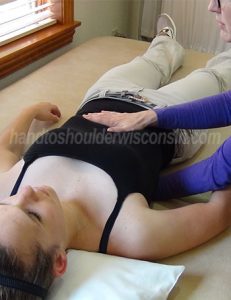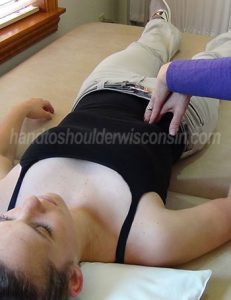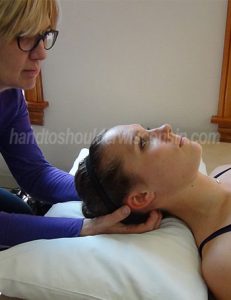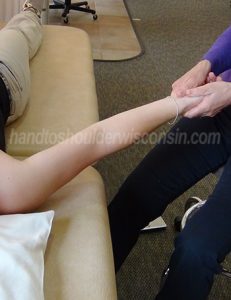The orthopedic specialists at Hand to Shoulder Center of Wisconsin are here to treat your myofascial pain. Our occupational and physical therapists have experience in safe hands-on myofascial release therapy. Contact Hand to Shoulder Center of Wisconsin in Appleton or Green Bay.
What is Fascia?
Fascia is a tough connective tissue that spreads throughout the entire body in a three-dimensional pattern from head to foot without interruption. Like a spider web, the fascia covers the muscles, bones, nerves, organs, arteries, and veins down to the cellular level. Each part of the entire body is connected to every other part by the fascia, much like the yarn in a sweater. When one area of the sweater is pulled, it affects another area due to the thread connection. This can also be true with fascia; when one area of the body feels pain, the base of the pain may be coming from another region within the body. Therefore, it’s important that you address not only the area of pain, for example, the shoulder but what may be the cause of the pain – abdominal scars, poor posture, etc.
Trauma, surgery, inflammation, poor posture, scars, bracing against pain, and even anxiety can bind down the fascia and solidify, causing abnormal pressure of approximately 2,000 pounds per square inch on any or all of these body parts. This can result in pain, lack of motion, and dehydration of the fluid component of the fascia causing it to lose its relaxed and wavy configuration and become like a straight-jacket.
Since many current standard tests such as x-rays, myelograms, CAT scans and EMG’s do not show fascial restrictions, many people suffering with pain may have fascial restrictions that need to be addressed. Currently, elastography, the study of addressing the elasticity of tissue, may help further address localization of fascial restrictions and help to better diagnose individuals experiencing pain.
Fascial restrictions can be cumulative. This means that some of the trauma could have been small and accumulated over time – even a fall when you were 2 years old can result in a pain response at a later time.
What is Myofascial Release?
Myofascial release therapy is a safe effective, hands-on technique. Myofascial release techniques involve a gentle, sustained, low load pressure into the restricted areas for sometimes up to as much as 5 minutes or more to one area. Myofascial therapy performed by a licensed therapist is used not to just stretch the tissue but elongate it (Fig. 1-4). Fascia tends to resist suddenly applied force and does not generally respond well to quick stretches, therefore, myofascial release therapy can be very beneficial in treating myofascial pain syndrome.
 Figure 1: Myofascial therapy is applied by a licensed therapist |
 Figure 2: Myofascial therapy is applied by a licensed therapist |
 Figure 3: Myofascial therapy is applied by a licensed therapist |
 Figure 4: Myofascial therapy is applied by a licensed therapist |
Each person with myofascial pain is looked at as a totally unique individual. Their treatment is focused specifically on their issues, not only addressing the area of pain but assessing and addressing the cause of the pain. It is not a “no pain no gain” type of treatment. Myofascial release therapy, a type of neuromuscular therapy, allows you to experience “therapeutic pain” which allows old tissue memory of injury or trauma to release. Many of us relate pain to injury but, in this case, when treatment and self-myofascial release exercises are done and you feel a type of pain or softening, it is probably your body’s way of telling you that what you are doing is appropriate.
Self-myofascial release is the treatment of incorporating various techniques which may include the use of a tacky ball and foam roller into your exercise program (Fig. 5-7). The fascial release effects provided by the use of a foam roller (typically referred to as foam roller therapy) in conjunction with your own body weight can facilitate release in multiple areas of your body. By rolling slowly over the foam roller and the targeted area, the foam roller stretches and elongates the fascia and actually allows you to reach deep muscle tissues.
 Figure 5: Tacky ball exercise |
 Figure 6: Foam roller exercise |
 Figure 7: Foam roller exercise |
With myofascial release or any type of alternative medicine therapy, it’s not always enough to simply go through the motions of the exercises but to fully participate by bringing ones full attention into the body or location of pain. Using one’s breath is also important to help soften or melt away the area of tightness or pain.
What can you expect with Myofascial Release?
When fascia releases, it can feel like taffy softening. Sometimes people may feel cold or heat, tingling or buzzing, burning, or a sense of water or air moving through the area. They may also notice a sensation in an area other than that being treated. This is called the “fascial voice” and is your body’s way of telling you that this area also needs to be elongated and given attention. People will generally notice an increase in their motion and increased function with less pain.
It is always important to drink plenty of water after treatment to help flush out metabolic wastes and re-hydrate the tissue.
Many of our therapists at the Hand to Shoulder Center of Wisconsin have been trained in variable myofascial release techniques which they incorporate in their treatment with simple hand, wrist, elbow, and shoulder injuries to complex traumas and pain of unknown cause.
Myofascial release is done in conjunction with patient participation through a home therapy program, understanding of their pain, and activity and work station modifications to reduce their physical and mental stressors. Our goal is to provide the patient with the tools to self-manage their pain and resume activities that they could no longer participant in and enjoy!